December 2-8, 2012. The dead are burned in Benares, on a huge ghat called Manikarnika. Two hundred on average are burned in a day, and up to three hundred during the busy times. Once I stood high up in a building near by. Looking down on the burning ghat, I counted twenty-one separate fires. And this was at a quiet time of the year. The fires burn from morning until late at night. It takes about three hours to burn a body, and costs about three thousand rupees. The wood used for each body is weighed and charged for. The bodies are carried on specially made bamboo stretchers through the narrow streets of the town and down the steps to the river, where they are dunked (stretcher, body, wrappings, cloth coverings, and all) into the river, into the sacred goddess Ganga, for purification. They are then laid out on the steps to dry in the heat of the day. After that they are placed on a pile of wood, more wood is stacked on top, ghee is added to act as an accelerant, and they are then burned to ashes.
The belief is that if you die and are cremated at Manikarnika you will escape the cycle of reincarnation and go straight to Nirvana. The river is held sacred. The town is held sacred, and Indians come from all over the country to bathe in the waters here. It’s a holy pilgrimage. If they can, the poor, the disabled and the suffering get themselves to Benares to die here, to be burned here, to escape the cycle of birth and death, and be freed from suffering. There are other burning ghats in India, and other holy cities on the Ganges, but Benares is regarded as the most sacred of all.
You are confronted with the reality of death here. There is no escaping it. Added to that our hotel was right next to the burning ghat so every time we went out we walked by it. I stopped many times and watched, taking in the truth of it. There was a fascination, and a reverence, and a curiosity, and a deepening acceptance. It was a pageant to behold, and a sacred ceremony, both at the same time. We all wanted more information, to understand the process and the ritual. For instance at one point during the burning, at the right time, a senior male member of the deceased’s family gets to beat the skull open with a big bamboo pole, to release the soul to fly free from the body. After the burning the ashes are released into the river.
There are five groups of people who are not cremated: children under thirteen, monks, and people who’ve been bitten by a cobra, because they are all considered pure already, pregnant women who are carrying a pure being, and lepers. We didn’t get a clear understanding as to why lepers aren’t burned – one theory was because the bodies smell bad when burning. Another person denied this. Those not burned are weighted and dropped deep into the middle of the river.
There is a group of families that burn the dead. The work is passed down from father to son, and has been for centuries. It is completely closed. You only get to work on the burning ghat if you are born into it. A bit like royalty really, except they are regarded as untouchables. The Burn Boss is the head of the senior family and he lives in a big mansion right next to the river.
There are enormous, truly enormous, piles of wood stacked in every available space all around the burning ghat. It is grown in plantations and is brought in by boat.
There’s an electric crematorium on a ghat further along the river. Cremations here cost about 500 rupees. It’s not used very much, and mostly by those who can’t afford wood burning at Manikarnika. People don’t like to mess with tradition.
No photo. No photo. No photo. That was the stern cry every time we walked by. In true Indian fashion we were also approached several times with the information that we could take photos. We’d just have to get permission from the Burn Boss, at which time, presumably, some money would change hands, both for the Burn Boss, and for the person who got his permission, if he actually even knew the Burn Boss, which is highly unlikely. No photo. No photo. No photo. And then we befriended a young man who we came to feel we could trust, and he took us into what appeared to be an abandoned building close by and we went high up and could look over Manikarnika and take a couple of photos. The next day we were wandering along the Ghats and stopped by a small postcard stand. There for sale were postcards of the burning ghat. Only in India.
This is a small portion of Manikarnika, the burning ghat
Some of the piles of wood tucked in amongst the buildings
Benares and the Ganga from the balcony of our hotel – photo by Don Read
A little further along the river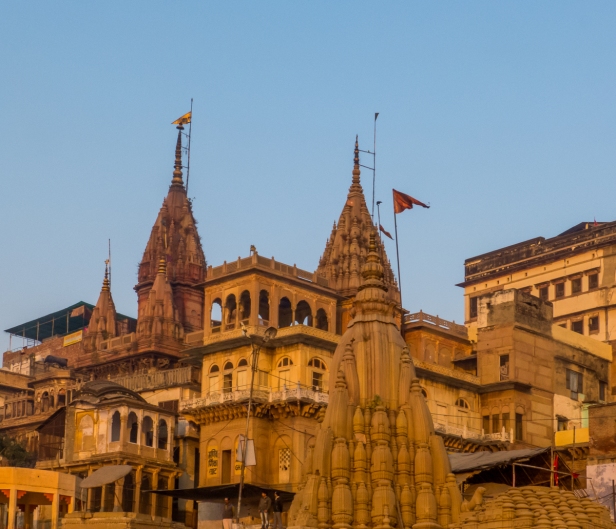
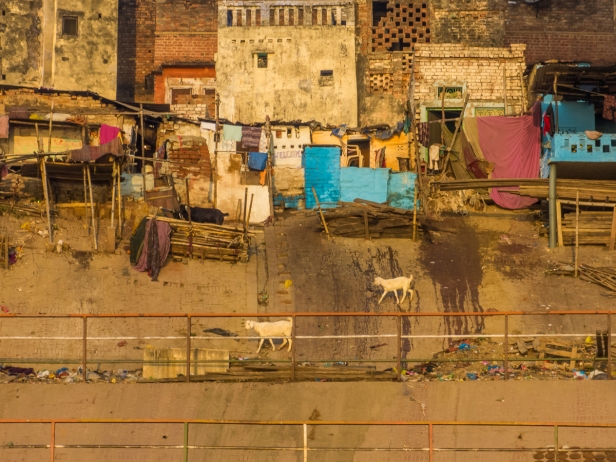
All of life happens on the ghats, those concrete steps and platforms that lead down to the river. It is an endless colourful carnival filling the senses: fascinating, exciting and exotic, unlike anything else. Praying and meditating, buying and selling, bathing bodies and washing clothes, sacred spiritual rituals that left us with a kind of gaping puzzlement, people just hanging out or taking an afternoon nap, families playing together, boatloads of people coming and going, goats, cows, cats, dogs, and chickens roaming freely, the buffalo man washing his herd daily, and the spectacular evening sacred ritual of Ganga Aarti.
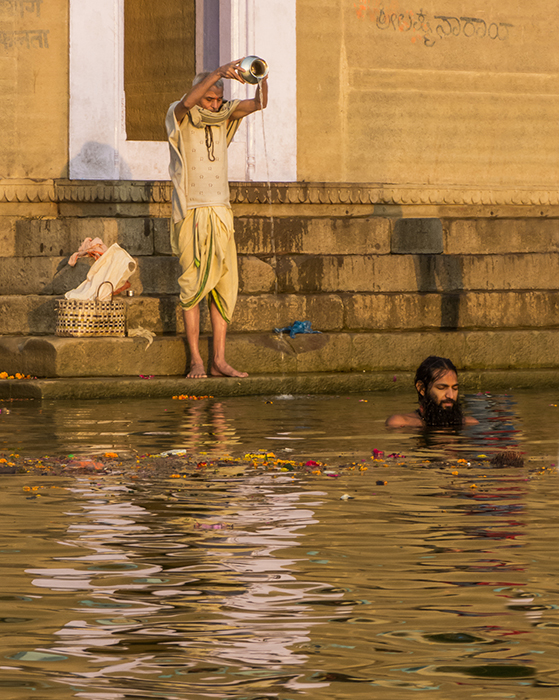
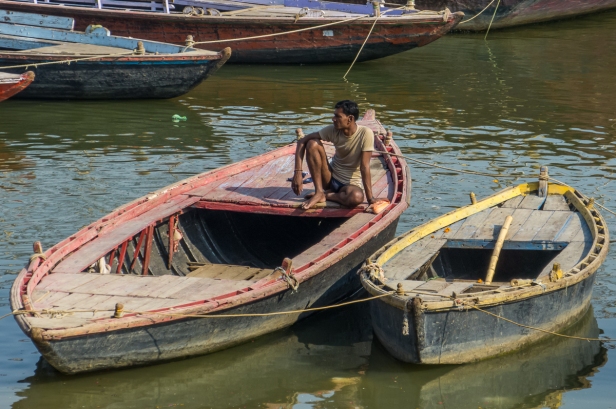
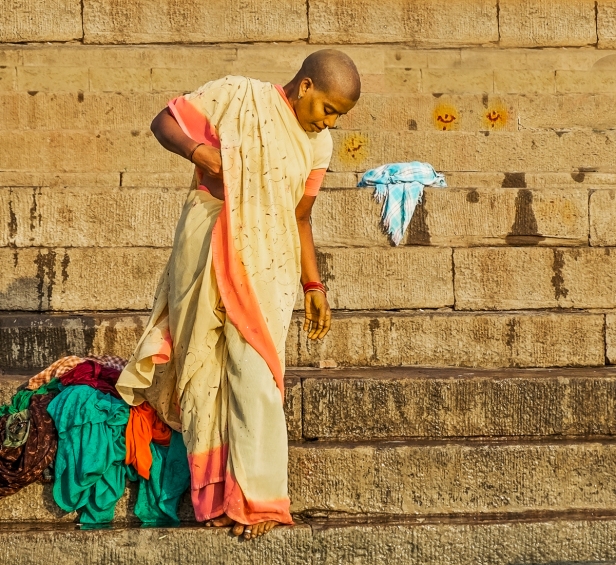
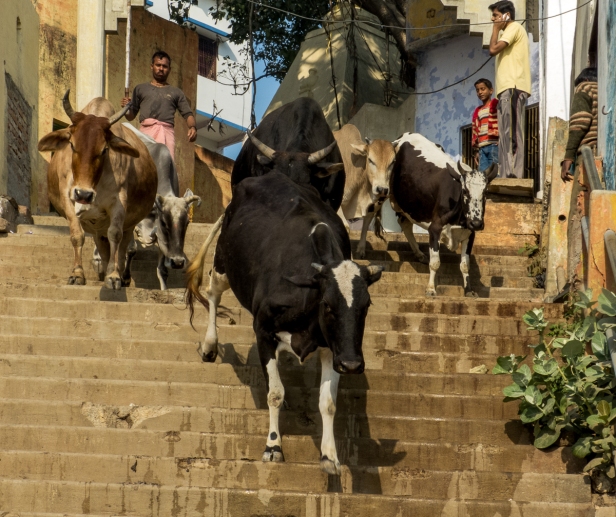
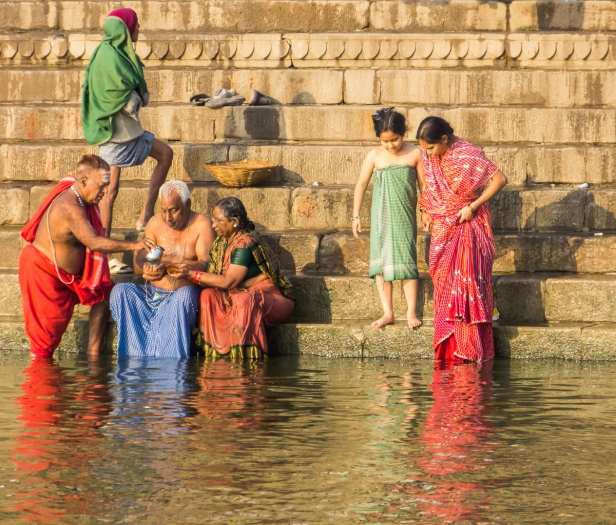
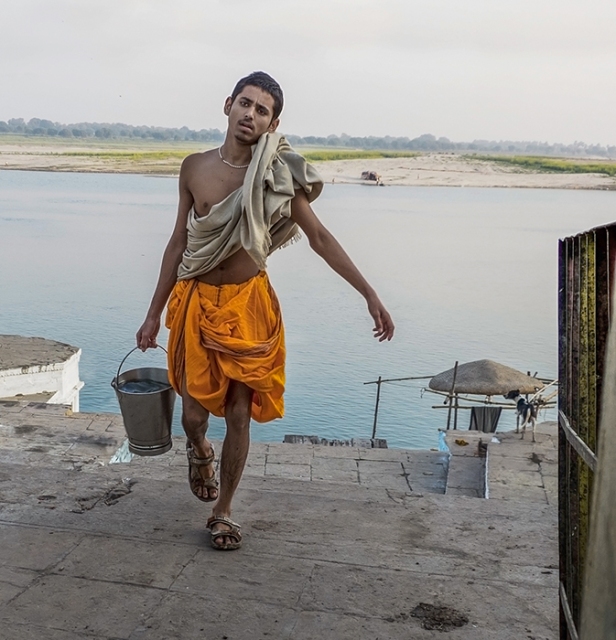
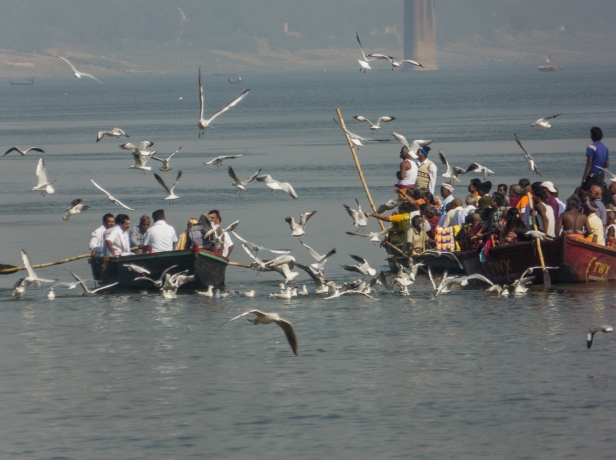
This man was one of a group of seven or eight men, all in a row along the river, each with a concrete “washboard” doing laundry. He is washing a sari, though most of them seemed to be washing the sheets from the hotels. There was a large sloping concrete embankment covered with sheets spread out flat to dry in the sun.
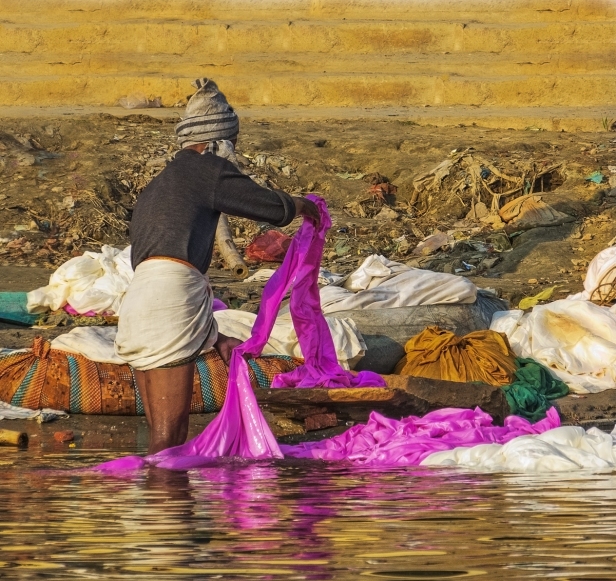
Sadhus, holy men, live on the ghats, in the open, with only a small cloth “tent” covering, or umbrella, or balcony above for shelter, studying spiritual texts, meditating, waiting to be released from the cycle of reincarnation. Each has his own spot that is his home.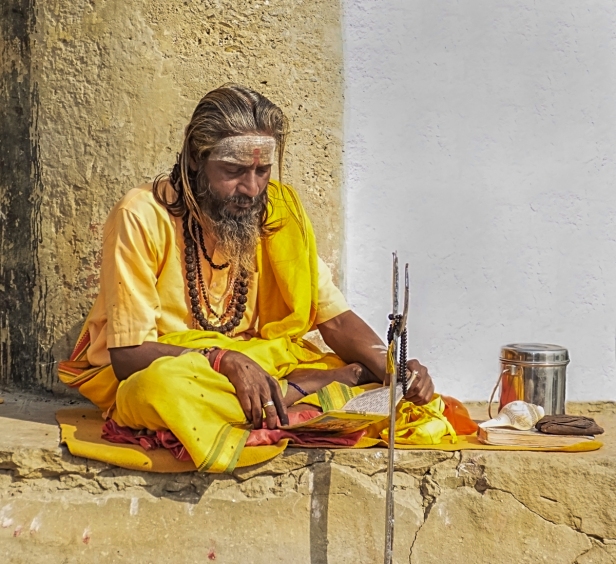

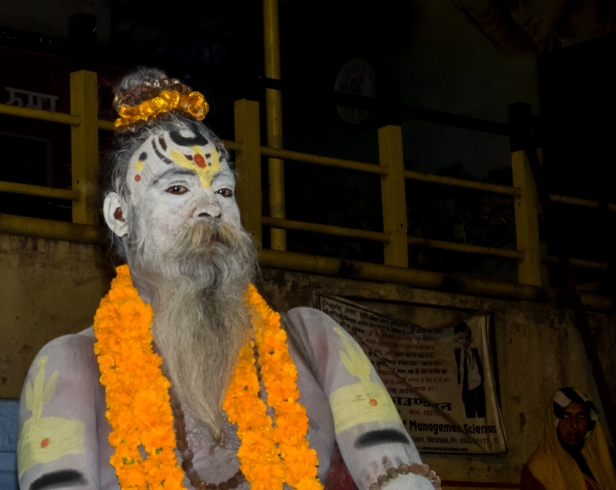
This man lives right here where he sits, beneath a balcony. We passed him almost every day. At night he would lie down right where he was, covering himself from head to foot with a blanket. He seemed to have some acolytes who sat with him, and perhaps brought him food. When not sleeping he was meditating or studying the sacred texts.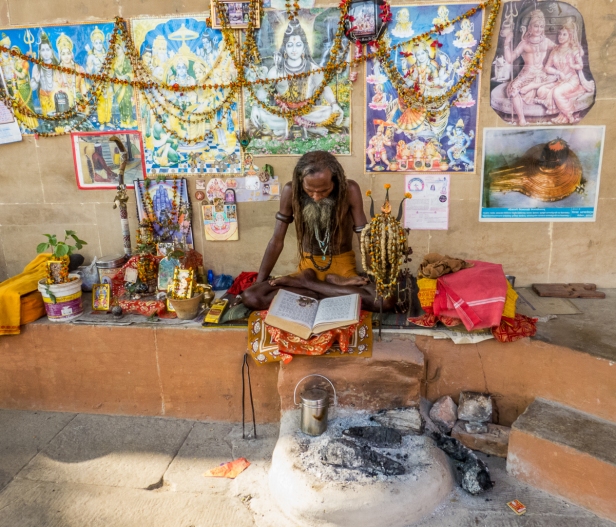
The main ghat, late at night, quiet. You can see two men asleep on their platform, each covered from head to foot in a blanket.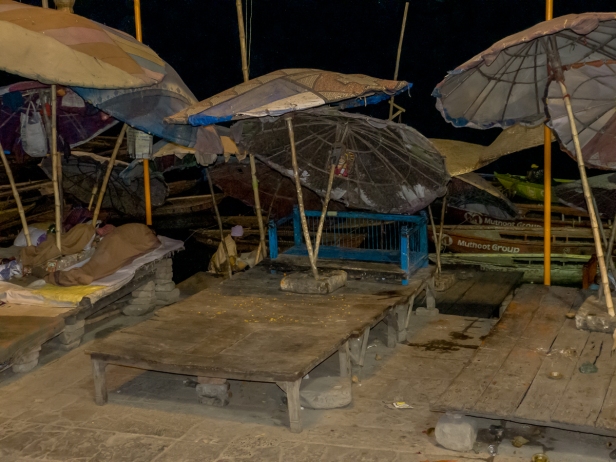
The main ghat during the day, always the busiest place, always people coming and going, by foot and by boat. It is the main entrance to the town, and the markets and shops, from the river.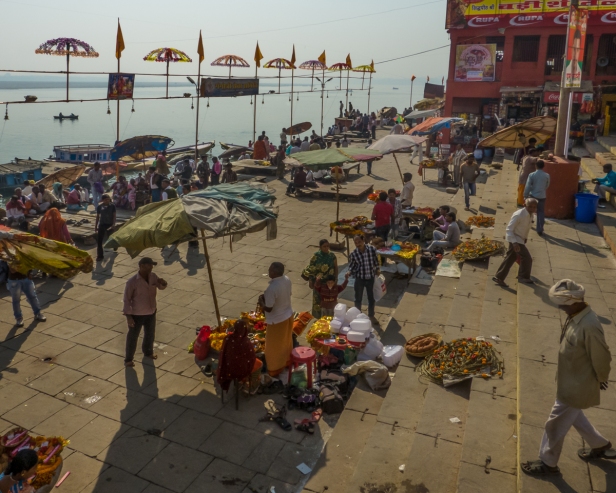
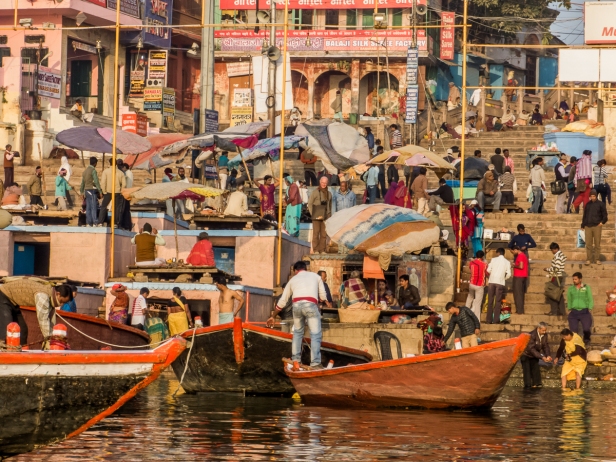
Just below our hotel families live in what look like small “basement” rooms that open onto the spacious concrete “shelf” that is the top of the ghat. It is their open-air living room furnished with several wooden platforms where the kids play, where they spread out sewing projects, where they sit and chat, and help each other with various chores and activities – like hair-styling.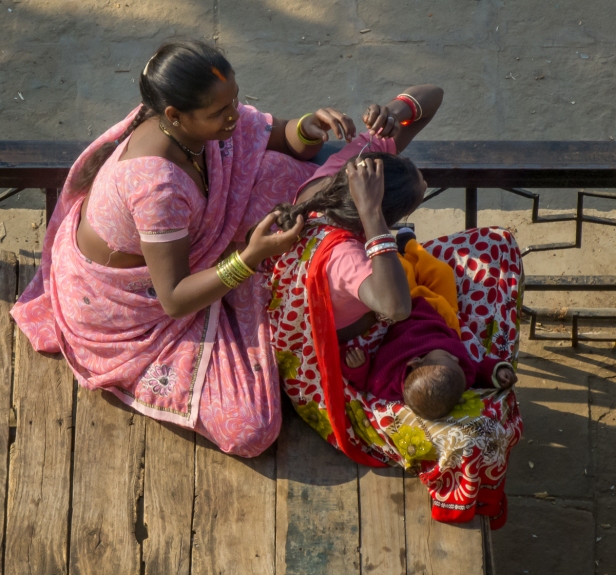
The Hindu ritual of Ganga Aarti is held every evening at dusk on the banks of the river at the main ghat, facing the river, a prayer and devotion to the goddess, to the Mother Ganga. It is highly stylized and choreographed, like any religious ceremony that has been performed throughout the ages. Hundreds come every night to watch and participate. It is conducted in two separate but adjacent places by the river, the same ritual, led by seven Brahmin priests in each place. Incense and candles are burned and moved in the air in stylized patterns, there is continuous live chanting and music, and bells are rung throughout. We went three times, completely enthralled, and completely welcomed by the Indian families surrounding us.
Preparing the altar on the centre platform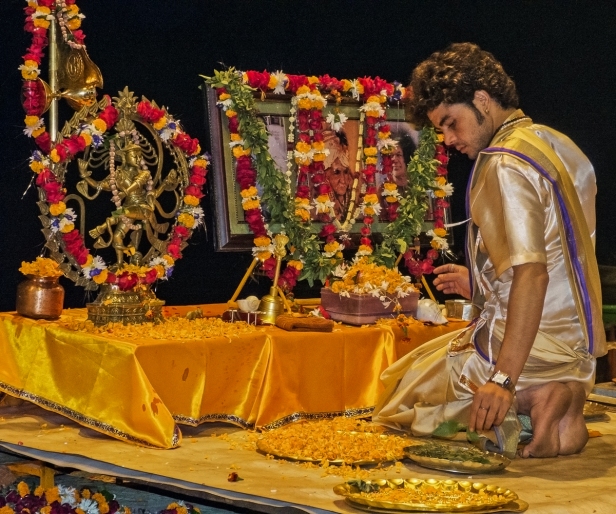
Lighting the candles that surround each platform

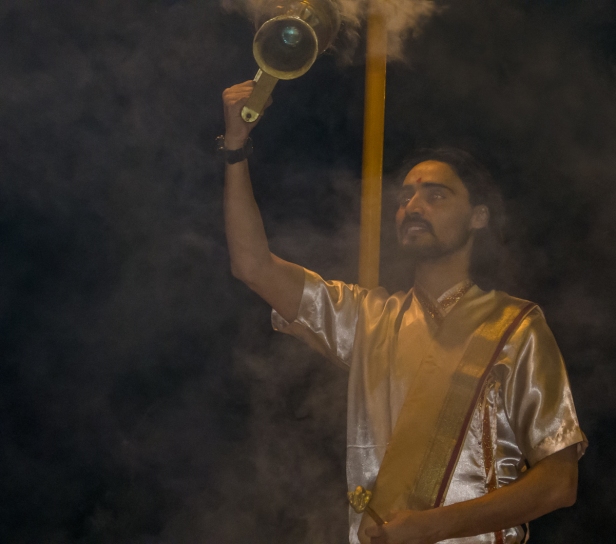
Benares, Varanasi and Kashi – three names for the same ancient town. All three names are still used. It is an amazing place. We couldn’t have imagined it. We couldn’t have imagined what a fabulous time we would have there; every day an adventure into new sights, sounds, joyous connection, and wide-eyed wonder that such a place exists. Really there is no describing it. It is India definitely, but it is also just itself, a sacred place that draws many many people seeking freedom, release, and the end of suffering. That alone brings a special energy that you cannot help but be affected by, even if it’s just the sight of all the different, unique and creative things people do in their quest to get closer to spirit. It is also recognized as a city of culture and learning, and we were lucky enough to stumble into some world class sarod, sitar and tabla music. We wouldn’t have missed it for the world. The perfect place to end our Indian odyssey.
Next post – leaving India, and a beach in Thailand to recover.
All words and images by Alison Louise Armstrong unless otherwise noted.
© Alison Louise Armstrong and Adventures in Wonderland – a pilgrimage of the heart, 2010-2015.

Wow! 😀
LikeLike
Thanks 🙂
LikeLike
Stunning photography as usual. What an amazing place to visit; I don’t like the sound of having to spend the night on hotel sheets that have been washed in that river with all that it contains.
LikeLike
Thanks Danny. Yes it is an amazing place.
I guess we didn’t even think about the hotel sheets. They never made any of us sick anyway. Yeah there’s a lot in that river! I saw a documentary recently suggesting that given what’s in it it must have some kind of antiseptic properties as well considering how any people regularly bathe in it. And when you get an entire nation of a billion people who revere it as a deity that energy alone must have some effect.
LikeLike
Alison, you are right about the antiseptic characteristic of the Ganges water. The entire nation of more than a billion carry Gange holy water in their homes and it is used in all religious rituals. This water can be kept for years in bottles and it remains same whereas any other water’s characteristics deteriorate. Our ancient scriptures have records that this water along with another holy river’s water (Saraswati is no more in existence) was used for making “Somras” a special medicine which used to prolong lives of then living human beings by making them young and strong.
Followers of ancient medical science which is known as ayurveda, still use Gange water for ,making various medicines. This river travels through great Himalaya,, which is a land of many ayurvedic plants and medicines..these medicines are found nowhere in the world. River travel through this might Himalaya and all these herbs also get mixed in its water. I hope I am able to give more reasons for why mother Gange water is special to every Indian. 🙂
LikeLike
Hi Sandeep, Yes this documentary I saw certainly confirmed the antiseptic qualities. I do believe the Ganga has very special qualities. Thank you for sharing all this information. I have actually had some Ayurveda treatments in the past and found them to be very powerful.
Cheers
Alison
LikeLike
All of your images linger with me. I have been seeing the man in the river with the colorful sheets since yesterday – when I see images like these so foreign and yet so intimate, i see that you are creating a merging of identity for those who take a look at your shots. to walk in this man’s steps – to share in this daily work so laborious, so messy, so endless, and yet so beautiful too. Thank you, alison.
LikeLiked by 1 person
Thank you so much. That means a lot to me, that those who look at the images get something of the feeling of being there, and get to share a little in the experience – my experience, and the experience of the people being photographed.
LikeLike
Is it the natural lighting, Alison, or is there something crystal clear with Benares. Beautiful photos. I love the sadhus. The man living under the overhanging is humbling. Here I am doing my self-righteous 40 minutes of meditation a day, and he is living a vipassana retreat everyday.
Thank you so much for sharing this incredible journey. Namaste, Kozo
LikeLike
Thanks Kozo.
It’s the natural light. Some of the “yellower” shots are taken in that lovely early morning light.
Your 40 minutes a day is magnificent! You’ve been given a different life. If your life was meant to be a continuous vipassana that’s what you’d be doing. You are living the perfect life for you, and it couldn’t/needn’t be any different.
Blessings
Alison
LikeLike
Wonderful imagery and photos.
Does it smell bad around the Burning Ghat? With the newly-washed dead drying in the sun, plus the burning….
LikeLike
Thanks Kate. No, no bad smell at the burning ghat, only smoke. Surprising eh?
LikeLike
This is another fabulous post – so much to learn about the world! Your photos are wonderful, but that river must have some SERIOUS mojo to handle what it does and to not smell or make people ill. I read that the Ganges was one of the top 5 polluted rivers in the world, so maybe you and Don have the mojo!
LikeLike
I do think that river has some serious mojo. Saw a doc recently about it having some kind of antiseptic properties. Also I really believe that when one billion people believe in the sanctity of something (ie the river) it must have some effect. All India believes the river is a deity, a goddess, so why would it harm them? I think there’s power in that.
LikeLike
Beautiful writing and photos. Safe travel to your next destination, Thailand. Paulette
LikeLike
Thanks Paulette.
I’m about 2 months behind in posts mainly because there was so much to share about our 6 weeks in India. Since then we’ve been to Thailand, Cambodia, Laos and now back in Thailand for a few days then off to Myanmar.
Safe travel so far (knocks on wood – I take *nothing* for granted!)
LikeLike
Any other river of the world or India, could have died with the kind of dirt and pollution this river is seeing in since last 100 yrs. But yes, It is mother Gange and most of the great civilization have developed on its bank. This river is sacred and its water has cured some serious illness of many people. It could have been due to the belief of people as I am also pretty logical in my thinking but yes its true. This river is special.
LikeLike
And I agree. What a powerful thing it is. I’m not surprised to hear it has cured people. It’s quite magical really.
LikeLike
Beautiful pic..loved reading the details. Though from India, never visited this part of India, definitely want to visit Benaras
LikeLike
Thanks Asha. Yes, do visit Benares. It is quite extraordinary. Just about our favourite place in India.
LikeLike
Your post is lovely…where did you and Don stay?
LikeLike
Thank you 🙂
We stayed here
http://www.scindhiaguesthouse.com
LikeLike
Wonderful post Allison. I have recently been to Kashi (Banaras) and just loved everything about this holy city. Kudos to your selection of stills and choice of words to describe this beautiful city. Please refer me which documentary have you watched on Gange? I am interested in seeing it.
LikeLike
Hi Sandeep. Thank you for your kind words. I’m glad you enjoyed the post. Benares, or Banaras, is such an amazing place. I don’t know the documentary, but my sister might. I’ll get back to you if I find out
Blessings
Alison
LikeLike
A short stay, it takes more time and introspection to start enjoying the city: enjoying it deeply and strongly enough to miss it when you are away. Return some time, for a longer and more fruitful stay. Do the circuit of Kasi, and try to imbibe the spirit of the place. Good luck!
LikeLike
Thank you Rajnish. Maybe one day we will return. It certainly is a special city.
Namaste
Alison
LikeLike
Thanks for calling it special. It’s special only for those who are on an internal quest, because it creates conditions conducive for their success. May you reach where you want to.
Namaste
LikeLike
May you also reach where you want to.
Namaste
Alison
LikeLike
Amen.
Namaste
LikeLike
Dear Alison – thanks for sending me the link to this post. I really enjoyed seeing Varanasi through your eyes 🙂 BTW I also enjoyed reading the notes with your gravatar pic. Take care.
Namaste
YC
LikeLike
Thank you. I’m so glad you enjoyed it. It’s an amazing place. Special.
Namaste
Alison
LikeLike
Hello Alison.
Great pictures. Right now i dont have the time to read your words, but later i will do it.
I love the colours. Great pictures one more time.
Cheers
jlneves
LikeLike
Thank you so much – glad you enjoyed the photos. And thank you for following our blog. I hope you enjoy the stories of our journey – both inner and outer
Cheers
Alison
LikeLike
Very interesting insight into life at Banaras ghats.
LikeLike
Thank you so much Sunil. It must be different to hear foreigner’s reaction to your country. We spent 3 months living in Tiruvannamalai, Tamil Nadu, and later spent 6 weeks travelling from Delhi, then around Rajasthan and then to Agra and Varanasi. We loved India for many reasons.
LikeLike
This is incredible! What an experience. India is a place we are aching to see. Once, again, your pictures and tales of the adventure were just riveting.
What a lovely share. 🙂
<3~Andrea
LikeLike
Thanks Andrea. Yes, go to India! It’s not always easy, but it is quite extraordinary. There’s no other place like it.
Alison
xox
LikeLike
Unbelievable magical place! Thank you so much for bringing us the essence of Varanasi through your beautiful photos and words. I wish I’ll be able to go there some time soon…
Take care***
LikeLike
Thank you for your kind words. I see you had a look at a couple of my posts about Bali, another magical place. Since then I’ve gotten a new camera and had many lessons in how to use it and lessons in Photoshop from my sister, a professional photographer. I can see the improvement in my photography since then. Now I feel ready for an even better camera!
I’m so glad you enjoyed this post. It is one of my favourites. I hope you can go to Varanasi soon. It is a really special place. Another favourite post is Burma part 2.
Thank you for following. I hope you enjoy the stories of our adventures, both inner and outer.
Blessings
Alison
LikeLike
I will definitely read the Burma post…
When I visited Tailand (many years ago..) I went to Chiang Mai and realized that all cultural things (masks, crafts, jewelry, fabrics etc) came from Burma. So I planned to go there the year after, but ultimately went to Indonesia…
So another destination in my “life list” of places to visit ))
LikeLike
Hi Guys
Just read your blog about Varanasi. My wife and I were there in 1989 and were both deeply moved by the experience. In many ways it was our favourite place in India. Somehow all of life, and death, come together there.
While we were there somebody suggested we take a sunrise boat ride on the Ganges. We were dragged out of bed at some ungodly hour and escorted through the maze of lanes until we arrived at a dock where our transportation awaited us. To say the boat was in poor shape is an understatement. However the two guys on the oars (who we christened Evinrude and Johnson) greeted us with broad smiles.
At the river we could not see more than a few yards due to the morning mist. The next hour or so were spent in virtual silence slowly moving down the river. As the mist slowly lifted Varanasi was revealed in all her glory. Somehow all l the colours seemed so much brighter in the morning sun.
As an added bonus we were surprised to see fresh water porpoises breaking water beside our boat. All too soon the trip was over but I don’t think we will ever forget that boat ride. I highly recommend doing this to anybody considering a visit to this wonderful city.
Happy trails.
Alan
LikeLike
Isn’t Varanasi extraordinary?! We loved it. A kind of magical place that you can’t really describe. That early morning boat ride sounds wonderful. I can imagine the colours of the city from the river in the soft morning sunlight. I would love to photograph that. And seeing porpoises must have bee the icing on the cake. I had no idea there were porpoises in the Ganges.
We’ve just come from the Amazon in Peru where we swam with pink dolphins. I also had no idea there were dolphins in the Amazon.
LikeLike
Your photographs are so very perfect! 🙂
LikeLike
Thank you so much Sucheta! ❤
LikeLike
😀 welcome
LikeLike
Fantastic fotos!
LikeLike
Thanks Cindy.
xo
LikeLike
Stunning photos as usual. I guess I followed in your footsteps because I went to SE Asia after India.
LikeLike
Thanks so much Jane. We loved SE Asia, and the first thing we did was to spend 2 weeks at a beach on a Thai island to recover from India 🙂
Alison
LikeLike
It’s intense, that’s for sure. But I love it anyway. I’m in Siem Reap right now–just had my first day visiting temples. This is my last stop in SE Asia. I head for the U.K. in five days.
LikeLike
Reblogged this on Cristian Mihai.
LikeLiked by 1 person
Thanks Christian.
Alison
LikeLike
Superb piece. Well written. The “escaping the cycle of life and death” begs the question, why do they create so much of it?
LikeLiked by 1 person
Thank you so much Edward. I appreciate your kind words.As for your question I have no answer no more than anyone else. It is what it is.
Alison
LikeLike
Very, very fascinating pictures and post.
LikeLiked by 1 person
Thanks so much Jacqueline. I’m glad you enjoyed it. Benares is a most extraordinary place. We’re really glad we went there.
Alison
LikeLiked by 1 person
You are most welcome 🙂
LikeLiked by 1 person
Reblogged this on s a gibson.
LikeLiked by 1 person
Thank you so much.
Alison
LikeLike
Thank you, great pictures and I appreciate the article.
LikeLiked by 1 person
Thanks so much Ken. Benares was fascinating, and, of course, a photographer’s dream.
Alison
LikeLiked by 1 person
Hello, I found this totally interesting and linked your post to my latest post; bridegroom wanted, urgently. Have a lovely weekend 🙂
LikeLiked by 1 person
Thank you so much Jacqueline. I really appreciate it.
Alison
LikeLike
A fantastic post on an important part of the city I love. The Benaras I lived in was spread around Lanka and the University, and I seldom visited the ghats so I also found your post informative. The Burn Boss, I guess, is the Dom Raja who lives in the mansion with the statue of a lion?
LikeLiked by 1 person
Thank you so much Anand. I’m glad you enjoyed the post. We certainly enjoyed being there. All I know about the Burn Boss is that the boatman who took us on a sunset cruise of the river pointed out his mansion to us. It’s a huge place right on the river somewhere between Manikarnika and the main ghat. I have written another post on Benares that you may be interested in:
Alison
LikeLike
Superb post Alison. Your photos of the ghats are outstanding! And you have such a gift for bringing places alive with your words. Chuckling at the “…..a beach in Thailand to recover” 🙂
LikeLiked by 1 person
Thanks so much Madhu. There was so much to photograph there! I really had trouble picking the ones to use in this post that best conveyed what it is like. Ah yes, after five weeks travelling like mad things around Delhi/Rajasthan/etc we travelled non-stop for 40 hours (plane/train/ferry/van) to arrive at a beach resort and collapsed for two weeks.
Alison
LikeLike